Reporting from the kingdom of fear
Mexico City, February 15, 2016 -- Like most people, I didn’t really know the definition of the word “cenotaph.” And then the word burned itself into my memory forever one afternoon in July 2011.
On that day, I was standing in front of a large cross erected on a cement pedestal covered in potted plants and flowers. A “cenotaph” is an empty tomb or monument erected in honor of a person who is buried elsewhere. In Mexico, where regions are wracked by drug violence, they are often erected on the spot where a person was killed. This particular one, in Mexico’s northwestern city of Culiacan, was put up in honor of Edgar Guzman Lopez, who was killed here in April 2008. Lopez was the son of Joaquin “El Chapo” Guzman, at the time one of Mexico’s most powerful drug barons.
I was in Culiacan with an AFP photographer and videographer gathering material for what seemed to us a non-dangerous story -- the influence that the drug trafficking rampant in the region was having on its cultural and artistic life. The locals told us that more and more cenotaphs were popping up in the region. “Ceno-what?” we asked, not familiar with the concept.
'What are you doing here?!'
Turned out there were dozens of cenotaphs in the streets of Culiacan, the capital of the Sinaloa state where drug trafficking is so omnipresent that it has affected the area’s fashion, music and architecture. Most of Culiacan’s cenotaphs were erected for youth who were killed in drug-related violence. They are decorated with string lights for Christmas, pumpkins for Halloween and small little hearts for Saint Valentine’s Day. The one for “El Chapo’s” son, whose murder sparked a particularly violent war between rival drug gangs, presides over a parking lot in a shopping center in a well-off part of town.
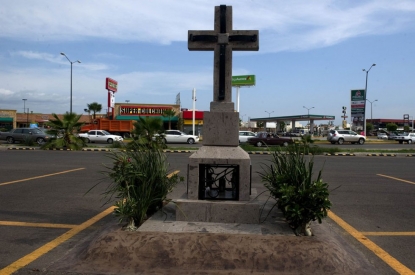 The cenotaph of Edgar Guzman Lopez. July, 2011. (AFP / Yuri Cortez)
The cenotaph of Edgar Guzman Lopez. July, 2011. (AFP / Yuri Cortez)When we got to the monument, the parking lot was practically deserted, with almost no cars nearby. The only other person we see is a man wearing a cap who, when he sees us, raises his cell phone to his ear. An informer for drug traffickers, what they call a “halcon” (“falcon”) here.
Our photographer Yuri Cortez and the cameraman take out their equipment when a sandy-colored car suddenly appears and races towards us, its tires screeching. When it reaches us, the tinted driver’s window lowers slowly. Inside we see armed men glaring at us.
“What are you doing here?!” they demand.
“We are doing a story on the town’s cenotaphs,” the video reporter answers. The men start to yell, threatening us and ordering us to leave at once. Pale as death, we get back into our car and leave the shopping mall. A few blocks away, we stop so one of us can throw up.
A dangerous place
That short incident was one of the few direct contacts that I have had in my journalistic career with the world of drug traffickers, whose ruthlessness, violence and impunity has made Mexico one of the world’s most dangerous countries for journalists.

Burying Juan Mendoza Delgado, director of a website "Writing the Truth" and former crime reporter at a local newspaper. Veracruz state. July, 2015. (AFP/Ilse Huesca)
Some 89 media workers have been killed and another 17 have gone missing in the country since 2000. The latest was a 32-year-old mother-of-two, Anabel Flores Salazar, who worked as a crime reporter for a newspaper in the eastern state of Velacruz and whose half-naked body was found dumped on a road in central Mexico last week, just days after an armed group wearing military-like clothes burst into her home before dawn and took her away.
In October 2015 world headlines were dominated by American actor Sean Penn’s interview with “El Chapo,” but in reality druglords are practically inaccessible and you can count the interviews they have given to the media on the fingers of one hand. Before Sean Penn, there was also an interview that “El Chapo’s” right-hand man Ismael “El Mayo” Zambada gave to the Mexican journalist Julio Scherer in early 2010.
These two interviews made a lot of noise. Sean Penn was reproached for not being a real journalist, for asking complacent questions. In both instances, the drug barons brought their interlocutors to their hideouts, took photos with them and forbid them to record their one-on-one conversations.

Sean Penn's interview with "El Chapo" makes the headlines. January, 2016. (AFP/Alfredo Estrella)
The idea that “El Chapo” offered a meal and tequila to Sean Penn and actress Kate Del Castillo, who played the intermediary, is shocking to many people in a country where drug cartels have terrorized and killed with often vicious cruelty those who they deemed got too close to them.
Frankly, both interviews are far from being interesting and shed little light on the lives of these murky personalities.
When covering the cartels in Mexico, journalists sometimes take part in visits organized by the authorities for the media. After “El Chapo” was arrested on January 8 in the town of Los Mochis, lots of journalists stood in line to take an army-organized tour of the house where he was hiding. They saw the last hideout of one of the most wanted drug traffickers in the world, the damage caused by the military assault on the hideout and the tunnel through which he escaped from the house, only to be captured nearby in a stolen car.

The house where "El Chapo" hid before his recapture. January, 2016. (AFP/Hector Guerrero)

The tunnel through which "El Chapo" tried to elude authorities before being recaptured. Sinaloa State. January, 2016. (AFP/Hector Guerrero)
A similar visit had been organized by the authorities in July 2015, when “El Chapo” escaped from the Altiplano high security prison in a getaway that made the world’s headlines. Back then we could see the cell where he was kept for 17 months, as well as the hole in the shower through which he made his getaway. We walked through the infamous corridor where Mexico’s most dangerous criminals are held; heard their voices, looked into their eyes.

View of the shower hole through which "El Chapo" escaped from a maximum-security prison. July, 2015. (AFP/Yuri Cortez)

Filming the cell from where "El Chapo" escaped. July, 2015. (AFP/Yuri Cortez)
Putting their lives on the line
These types of stories are interesting. But the stories where journalists really put their lives on the line are those when they investigate the suffering the drug cartels have left in their wake throughout the country. While interviewing a major drug kingpin certainly poses some danger, it’s nothing compared to the risks taken by journalists working in the regions, where the drug cartels reign with impunity.
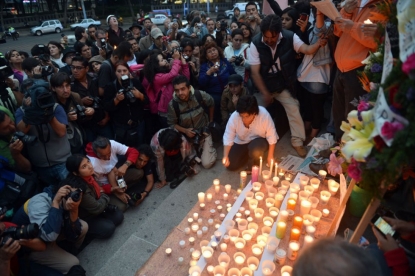 A vigil against violence against the press. Mexico City. May, 2012. (AFP / Yuri Cortez)
A vigil against violence against the press. Mexico City. May, 2012. (AFP / Yuri Cortez)An example. In 2011, AFP photographer Ronaldo Schemidt and I were in Durango, in Mexico’s north, where some 300 bodies had been discovered in dozens of spots, some of them in the center of the city. Noone wanted to talk to us. When we approached people, they would stop talking, slam doors in our face. And then we happened upon a dantesque scene.
In a small parking lot in front of the state prosecutor’s office, two refrigerated trucks are parked, their motors idling. Inside are human remains wrapped in white sheets, stained with blood and bodily fluids. Two forensic doctors are in the middle of performing autopsies on the bodies laid out on the trucks’ backdoors, right out in the open air. On the ground are other bodies, covered by shrouds. There are so many bodies that no morgue in town can accommodate them all.
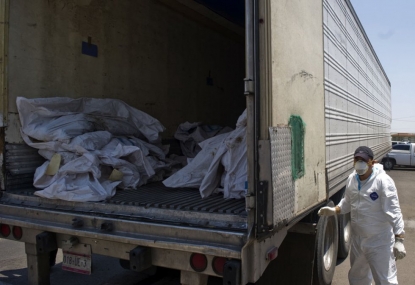 A truck with the bodies discovered in mass graves across the city of Durango. May, 2011. (AFP / Ronaldo Schemidt)
A truck with the bodies discovered in mass graves across the city of Durango. May, 2011. (AFP / Ronaldo Schemidt)A whiff of putrid smell hits me in the face. I have to lean against a wall in order not to vomit. Ronaldo and another photographer are in the middle of taking pictures when a group of agents from the prosecutor’s office rush out of the building. A local journalist who was with us starts hightailing it and we follow. The authorities, which in Mexican regions are often in cahoots with the drug cartels, clearly did not appreciate us sticking our noses where they didn’t belong. Until now, noone knew exactly the location of the discovered bodies.
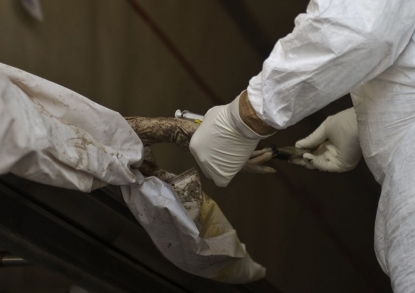 Forensic personnel take samples from one of the bodies found in the Durango mass graves. May, 2011. (AFP / Ronaldo Schemidt)
Forensic personnel take samples from one of the bodies found in the Durango mass graves. May, 2011. (AFP / Ronaldo Schemidt)That same day, we receive a veiled threat. We are accused of stealing confidential information. If we were in a country where the justice system was working normally, we wouldn’t be worried. But in Durango, where the drug traffickers ride through the streets in the same vehicles as agents from the prosecutor’s office, it is difficult to determine exactly whose cars are tailing us throughout the day. Everywhere we see the “falcons,” watching us. We don’t sleep well that night.
Beware of falcons
Another example. In October 2014, we arrive in Iguala a few days after the disappearance of 43 students from the Ayotzinapa school. The “falcons” follow us everywhere we go, including inside the hotel where we are staying, filming us with their cell phones and cameras. We receive not-so-subtle threats. One night, there are death threats on Twitter against foreign reporters. The following morning, there is a false report that a cameraman had been kidnapped and decapitated.
During one day of that reporting mission, we are walking in the sierra under a baking sun. We have navigated the roadblocks blocking access to the area where police, helped by dogs, are looking for the missing students. All of the sudden, we see armed men. We drop to the ground behind some bushes, hoping that they didn’t see us. We hear them stop near us, reload their weapons. They had to have seen something move. But luckily they don’t find us and continue on their way.
 Vigilante groups search for missing students in the Guerrero state. October, 2014. (AFP / Yuri Cortez)
Vigilante groups search for missing students in the Guerrero state. October, 2014. (AFP / Yuri Cortez)As I lay on the ground, I ask myself “why put myself in this situation? Is it really worth it?” We’ve been covering the story of the missing students for days. And each night I am exhausted, both physically and emotionally. But I tell myself that it’s important to tell the world of what is happening here, of this tragedy suffered by the victims, and with this, maybe bring a bit of justice to all those bodies under shrouds and body bags -- some of them bodies of journalists.
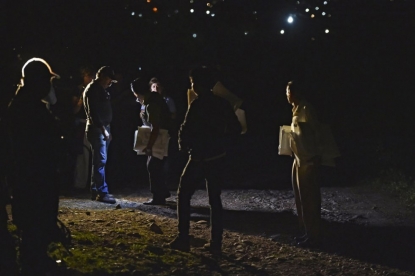
Policemen hold white body bags as they arrive at the site of a mass grave in the Guerrero state. October, 2014. (Yuri Cortez)
Journalists living in areas controlled by drug gangs in Mexico do not so much face the risk of dying in an armed confrontation, but more of being kidnapped in a blink of an eye. This can happen at the doors of your newspaper. Or when you’re at a friend’s house. You’ll be forced to get inside a van and then you’ll be found dead or you’ll never be heard from again. Very rarely do people return from such kidnappings alive.
 A farmer works a poppy field in Guerrero State. January, 2016. (AFP / Pedro Pardo)
A farmer works a poppy field in Guerrero State. January, 2016. (AFP / Pedro Pardo)In May 2012, I visited Veracruz, where three photographers and one administrative worker of a newspaper were found dead in a canal a day after disappearing. Their relatives and colleagues are besides themselves. At the time, two drug cartels were at war with each other, fighting for control over criminal activity in the region. “And we journalists are caught in the crossfire,” told me a reporter at the newspaper, who said he was going to change professions.
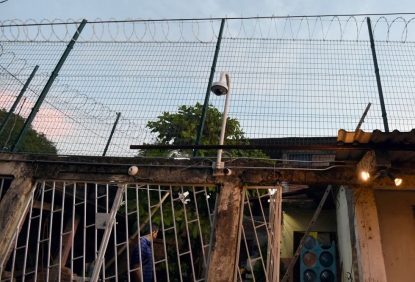 The entrance to the house of a Mexican journalist, Jorge Sanchez, whose father Moises was also a journalist and was killed. Veracruz State. August, 2015. (AFP / Alfredo Estrella)
The entrance to the house of a Mexican journalist, Jorge Sanchez, whose father Moises was also a journalist and was killed. Veracruz State. August, 2015. (AFP / Alfredo Estrella)All of the newspaper staff are on edge. “Last night I didn’t go home to sleep,” said one. Another told us of a directive from the paper -- under no circumstances are they to attend their colleagues’ wakes or funerals. Instead of expressing solidarity with the victims, the newspaper owners want to distance themselves as much as possible from them, to avoid the cartels’ wrath. The daily AZ, where one of the killed photographers worked a few months prior, went so far as to publish his resignation letter, to show that the paper had no more ties with him. They published it on the day of his funeral.
A dreaded, fatal summons
A photographer who covers the police, and thus is particularly exposed to reprisals by the cartels, told me how the Zetas cartel had a habit of “summoning” journalists with whom it was not happy to teach them a lesson. I ask him what kind of lesson. “They beat you with a bat in front of your colleagues,” he told me. The offending reporter is beaten on his bare buttocks until they bleed in a public reprimand.

The alleged leader of the assassins of the Los Zetas drug cartel, Marcos Jesus Hernandez Rodriguez ("El Chilango") after his arrest. May, 2012. (AFP/Yuri Cortez)
The day after the Veracruz bodies were discovered I and three colleagues visit the house of Gabriel Huge and his nephew Guillermo Luna, two of the victims. It’s a modest house. The room where the coffins are laid out is unbearably hot. As they enter the house with me, the three colleagues dissolve into sobs -- after days and days of stress and tension, they let go.
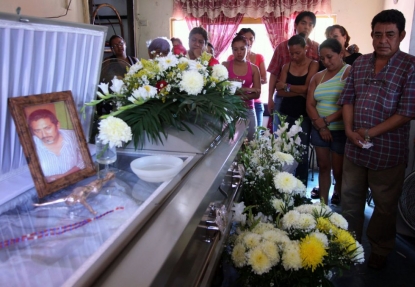 The coffins of Gabriel Huge and his nephew Guillermo Luna. May, 2012. (AFP / Lucas Castro)
The coffins of Gabriel Huge and his nephew Guillermo Luna. May, 2012. (AFP / Lucas Castro)While there, I learn that Gabriel and his 22-year-old nephew were “summoned.”
Before going to the fatal appointment,, Gabriel left his motorcycle to a friend and asked him to look after his daughter in case he didn’t come back. Then he left his camera to his sister and bid her adieu. I learn this from the sister herself at the funeral. She is completely lost -- she has lost both her brother and her son.
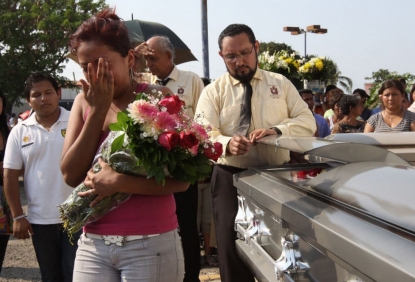 Saying good-bye to Guillermo Luna and Gabriel Huge. May, 2012. (AFP / Lucas Castro)
Saying good-bye to Guillermo Luna and Gabriel Huge. May, 2012. (AFP / Lucas Castro)The day of his disappearance, Guillermo worked as usual, covering police activities like he did every day. Before leaving for his “summons,” he took the memory card out of his camera and gave it to a colleague, telling him to pass it on to the newspaper’s editors in case he didn’t return quickly.
Their bodies were found on May 3, international press freedom day.
Leticia Pineda is an AFP journalist based in Mexico City. Follow her on Twitter. This blog was translated into English by Yana Dlugy in Paris.
 The cemetery in Durango. May, 2011. (AFP / Ronaldo Schemidt)
The cemetery in Durango. May, 2011. (AFP / Ronaldo Schemidt)

